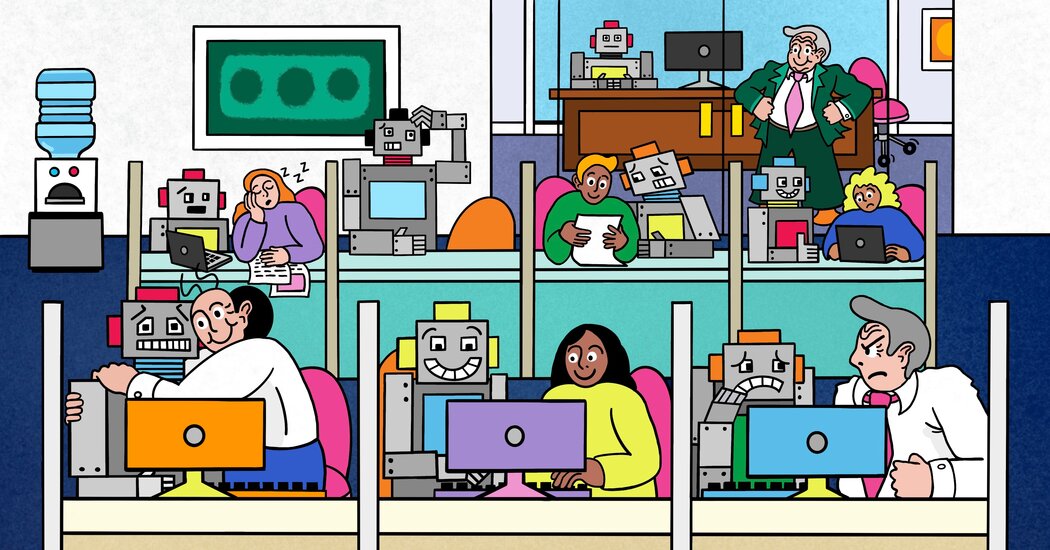
Earlier this year, Mark Austin, the vice president of data science at AT&T, noticed that some of the company’s developers had started using the ChatGPT chatbot at work. When the developers got stuck, they asked ChatGPT to explain, fix or hone their code.
It seemed to be a game-changer, Mr. Austin said. But since ChatGPT is a publicly available tool, he wondered if it was secure for businesses to use.
So in January, AT&T tried a product from Microsoft called Azure OpenAI Services that lets businesses build their own A.I.-powered chatbots. AT&T used it to create a proprietary A.I. assistant, Ask AT&T, which helps its developers automate their coding process. AT&T’s customer service representatives also began using the chatbot to help summarize their calls, among other tasks.
“Once they realize what it can do, they love it,” Mr. Austin said. Forms that once took hours to complete needed only two minutes with Ask AT&T so employees could focus on more complicated tasks, he said, and developers who used the chatbot increased their productivity by 20 to 50 percent.
AT&T is one of many businesses eager to find ways to tap the power of generative artificial intelligence, the technology that powers chatbots and that has gripped Silicon Valley with excitement in recent months. Generative A.I. can produce its own text, photos and video in response to prompts, capabilities that can help automate tasks such as taking meeting minutes and cut down on paperwork.
To meet this new demand, tech companies are racing to introduce products for businesses that incorporate generative A.I. Over the past three months, Amazon, Box and Cisco have unveiled plans for generative A.I.-powered products that produce code, analyze documents and summarize meetings. Salesforce also recently rolled out generative A.I. products used in sales, marketing and its Slack messaging service, while Oracle announced a new A.I. feature for human resources teams.
These companies are also investing more in A.I. development. In May, Oracle and Salesforce Ventures, the venture capital arm of Salesforce, invested in Cohere, a Toronto start-up focused on generative A.I. for business use. Oracle is also reselling Cohere’s technology.
“I think this is a complete breakthrough in enterprise software,” Aaron Levie, chief executive of Box, said of generative A.I. He called it “this incredibly exciting opportunity where, for the first time ever, you can actually start to understand what’s inside of your data in a way that wasn’t possible before.”
Many of these tech companies are following Microsoft, which has invested $13 billion in OpenAI, the maker of ChatGPT. In January, Microsoft made Azure OpenAI Service available to customers, who can then access OpenAI’s technology to build their own versions of ChatGPT. As of May, the service had 4,500 customers, said John Montgomery, a Microsoft corporate vice president.
For the most part, tech companies are now rolling out four kinds of generative A.I. products for businesses: features and services that generate code for software engineers, create new content such as sales emails and product descriptions for marketing teams, search company data to answer employee questions, and summarize meeting notes and lengthy documents.
“It is going to be a tool that is used by people to accomplish what they are already doing,” said Bern Elliot, a vice president and analyst at the I.T. research and consulting firm Gartner.
But using generative A.I. in workplaces has risks. Chatbots can produce inaccuracies and misinformation, provide inappropriate responses and leak data. A.I. remains largely unregulated.
In response to these issues, tech companies have taken some steps. To prevent data leakage and to enhance security, some have engineered generative A.I. products so they do not keep a customer’s data.
When Salesforce last month introduced AI Cloud, a service with nine generative A.I.-powered products for businesses, the company included a “trust layer” to help mask sensitive corporate information to stop leaks and promised that what users typed into these products would not be used to retrain the underlying A.I. model.
Similarly, Oracle said that customer data would be kept in a secure environment while training its A.I. model and added that it would not be able to see the information.
Salesforce offers AI Cloud starting at $360,000 annually, with the cost rising depending on the amount of usage. Microsoft charges for Azure OpenAI Service based on the version of OpenAI technology that a customer chooses, as well as the amount of usage.
For now, generative A.I. is used mainly in workplace scenarios that carry low risks — instead of highly regulated industries — with a human in the loop, said Beena Ammanath, the executive director of the Deloitte A.I. Institute, a research center of the consulting firm. A recent Gartner survey of 43 companies found that over half the respondents have no internal policy on generative A.I.
“It is not just about being able to use these new tools efficiently, but it is also about preparing your work force for the new kinds of work that might evolve,” Ms. Ammanath said. “There is going to be new skills needed.”
Panasonic Connect, part of the Japanese electronics company Panasonic, began using Microsoft’s Azure OpenAI Service to make its own chatbot in February. Today, its employees ask the chatbot 5,000 questions a day about everything from drafting emails to writing code.
While Panasonic Connect had expected its engineers to be the main users of the chatbot, other departments — such as legal, accounting and quality assurance — also turned to it to help summarize legal documents, brainstorm solutions to improve product quality and other tasks, said Judah Reynolds, Panasonic Connect’s marketing and communications chief.
“Everyone started using it in ways that we didn’t even foresee ourselves,” he said. “So people are really taking advantage of it.”













